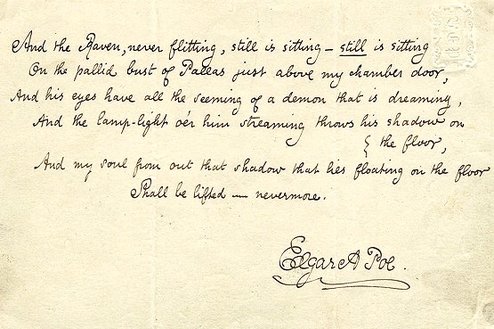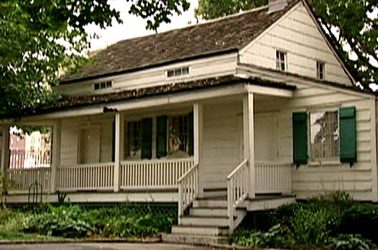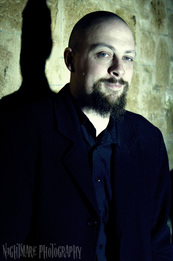
Known for his dark and macabre writing, Edgar Allan Poe lived up to his literary reputation by dying a very strange and unusual death, aged 40, in the year 1849, leaving an unsolved mystery.
Once upon a midnight dreary....
 The Raven, final stanza.
The Raven, final stanza. On 19 January, 1809 Edgar Poe was born to David, a native of Baltimore in the US and Elizabeth, who was born in England and travelled to America in 1796. The couple had three children all up, Henry, Edgar and Rosalie. Alas the marriage was not to be! The Poe’s were travelling actors, and absolutely dirt poor! It is debateable whether David left Elizabeth, or Elizabeth left David. All that is known is that Elizabeth ended up on her own with three small children.
When Edgar was only two years old his mother died of tuberculosis. Apparently his father also passed away of that exact same thing, within days of his estranged wife. The thee Poe children were then split up.
Rosalie, the youngest, was adopted by a family named McKenzie. Henry, the eldest, was raised by their paternal grandparents, and Edgar was fostered by the Allan’s – a quite affluent family who gave him a childhood of good schools and nice surroundings – for example, at the age of six he moved to England with his family, and was sent to a good school on the outskirts of London for 5 years.
When Edgar was fifteen he wrote his first poem “Last night, with many cares & toils oppres’d, Weary, I laid me on a couch to rest.”
Unfortunately John Allan, Edgar’s stepfather, did not particularly like him. He called him a ‘punk’. He said Edgar was ungrateful for all the couple did for him. And he had a point... Poe enrolled at the University of Virginia, where he was a good student, but where he discovered the demon liquor and gambling. By the end of the first semester he had accumulated a $2,000 debt – which was a large sum for the time. His stepfather refused to pay the debt, and Poe left the University and fled to Baltimore to stay with some relatives.
 Edgar Allan Poe.
Edgar Allan Poe. By now Edgar had had a few books published, so he thought he may be able to make a living as a writer. He moved to New York City, had some poetry published and submitted stories to several magazines. All were rejected. He was living on absolute poverty. He wrote to his stepfather and begged for assistance, but John Allan ignored him. When he died in 1834, Edgar was not mentioned in his Will.
Edgar finally got a job in 1835, as an editor of a newspaper. He got this job because of a contest he won with his story “The Manuscript Found in a Bottle”. With things looking up, he sent for his Aunty, Mrs Clemm and his cousin Virginia to come and live with him – because he was engaged to be married...
When Edgar was 27 years old he wed his cousin Virginia. She was only 13 years old at the time – they married before her 14th birthday in May, 1836. What. The. Hell? In a letter to her mother, proposing marriage, Edgar wrote "I love, you know I love Virginia passionately devotedly. I cannot express in words the fervent devotion I feel towards my dear little cousin — my own darling. Ask Virginia. Leave it to her. Let me have, under her own hand, a letter, bidding me good bye — forever — and I may die — my heart will break — but I will say no more." There is some talk that Edgar and Virginia were more like brother and sister, and never actually consummated their marriage. Other accounts state they were very affectionate towards each other – so I guess we will never know, but everything indicates to the marriage being a happy one.
 Poe Cottage.
Poe Cottage. I could write all about his articles and his poetry and his books, but I would really like to focus just on Poe. All of his life he struggled with money. In January, 1842, things were looking up for the Poe’s. One night Edgar was singing at the piano, when his wife began to bleed from the mouth – a symptom of tuberculosis. It took five years, but in 1847 she succumbed to the same illness that killed both of his parents and his brother Henry. During the intervening years the couple had moved back to New York City, where he published his most successful poem The Raven. It brought him fame – everybody had heard The Raven, but it did not support him financially, and it was the pinnacle of his success.
When Virginia died in 1847, people believed that Poe went insane, although he denied the charge, claiming that he was just grieving, and that his beloved wife’s death sent him into a downward spiral of depression and alcohol, and one that he never really recovered from.
A Strange Death and Grave-side Mystery...
 Grave marker for the current burial.
Grave marker for the current burial. All that is known is that on 3 October, 1849, Edgar Allan Poe was found either in a Baltimore gutter or a park bench (the stories vary). He was not wearing his own clothes, the clothes he had on did not fit him. He was delirious and talking nonsense. He was taken to a hospital where he perished, four days later, at the age of 40, on 7 October, 1849.
There are many theories surrounding his death. Did he die of heart disease, a brain tumour, tuberculosis, alcoholism, diabetes, epilepsy, a drug overdose, carbon monoxide poisoning or rabies? We will never know.
As with so many classical artists, this man who died in a gutter, destitute and filthy, is now one of the greatest literary heroes the world has seen. I can only hope he knows how appreciated his work is today.
A legend has sprung up around Poe’s burial site. A mysterious person, nicknamed The Poe Toaster, paid an annual tribute to Edgar Allan Poe annually, for several decades. A shadowy figure, wearing all black, a wide-brimmed hat, and a white scarf would visit the grave every year, pour a glass of cognac, raise a toast to the memory of Edgar Allan Poe, and then disappear, leaving three roses in a particular arrangement on the grave, together with the unfinished bottle of cognac. The person did not want acclaims or fame, and was never identified.





 RSS Feed
RSS Feed
